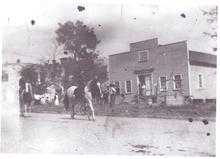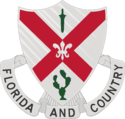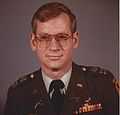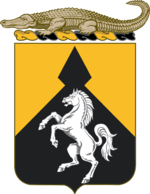Troop C, 1-153 Cavalry
| Troop C, 1-153rd Cavalry | |
|---|---|
|
153rd Cavalry coat of arms | |
| Active | 1897-present |
| Country | United States |
| Allegiance |
|
| Branch | Florida Army National Guard |
| Type | Infantry |
| Role | Reconnaissance, surveillance, and target acquisition |
| Size | Troop |
| Garrison/HQ | Tallahassee, Florida |
| Nickname |
"Governor's Guards" "Regulators" |
| Engagements |
American Civil War World War I World War II Operation Iraqi Freedom Operation New Dawn |
| Decorations | Philippine Presidential Unit Citation |
| Insignia | |
| 153rd Cavalry distinctive unit insignia |
.png) |

C Troop, 1st Squadron, 153rd Cavalry ("Charlie Troop") of the Florida Army National Guard was reorganized in 2006-07 from A Company, 3rd Battalion, 124th Infantry. The Tallahassee based company has official history dating back to about 1897.[1] However, the company, like the 124th Infantry Regiment claims its roots back to the Civil War and Florida's 12 infantry regiments in the two Florida brigades. For nearly all of the over 100 years of the company's existence it has been an infantry unit. There were only six years where the unit was changed into an armored scout troop before reverting to an infantry company. Today, Charlie Troop, is a dismounted infantry reconnaissance troop.
Post Civil War and Spanish–American War (1897-1916)
The first post-Civil War unit in Tallahassee was organized as Company C, 4th Battalion, Florida State Troops, the "Governor's Guards", on March 4, 1897; one company among 20 throughout the State Troops.[2] Company C conducted their first "annual camp of instruction" at Camp Henderson on Leon Heights near Tallahassee with all of the Florida State Troops during May 18 – 25, 1897. During this encampment two U.S. Army officers, Captain Thomas M. Woodruff and Hunter Liggett of the 5th U. S. Infantry, acted as instructor and inspector. “All of the companies have obtained a considerable degree of excellence, but Company C, Fourth Battalion, organized in Tallahassee only in February, was deserving of the greatest praise in proficiency and progress,” Major General Patrick Houstoun, Adjutant General. Captain Liggett rated the whole Florida State Troops, “Proficiency in battalion drill, fair in close order; fair in extended order; in ceremonies, excellent. Guard mounting very well done.” During this period, units had one drill per week, usually practicing the manual of arms and simpler company movements.[3]
In 1898, Florida was asked by the U.S. government to provide one regiment of 12 companies for service in the Spanish–American War. Company C was disbanded on May 23, 1898 along with other units to meet this requirement. While many from Tallahassee volunteered and served, they did not serve as a company from Tallahassee. In fact, the 20 companies from around the state were consolidated, reorganized, and mustered into federal service 20–25 May 1898 at Tampa as the 1st Florida Volunteer Infantry. The Florida regiment did not deploy overseas and eight of the companies were mustered out 3 December 1898 at Tampa and four companies mustered out 27 January 1899 at Huntsville, Alabama. The Florida units were reorganized 17–18 August 1899 in the Florida State Troops as the 1st and 2nd Regiments of Infantry.[2]
The infantrymen from Tallahassee were reorganized as Company D, 1st Florida Infantry in 1899 and were activated for state service May 3–22, 1901 to aid in relief during the Jacksonville Great Fire of 1901. Company D disbanded July 15, 1904.[4]
The unit was reorganized as Company C, 1st Infantry on June 7, 1907 and conducted a joint coast defense exercise in Pensacola in the same year. Company C was activated for state duty from October 30 to November 15, 1912 to help restore order during the violent Railway Strike in Jacksonville.[5] The unit was redesignated Company I, 1st Florida Infantry on March 19, 1915.[6] It was disbanded June 14, 1916, for falling below a Federal inspection standard.[4][7]
Mexican Border, Great War, and buildup (1916-39)
The Tallahassee infantrymen, as part of the 2nd Florida Infantry Regiment, mustered into federal service in June 1916 at Camp Foster, Florida and then deployed to the Texas-Mexico border in support of the Punitive Expedition against Pancho Villa. During their border service they used the time to drill and get ready for the Great War. Second Florida mustered out of federal service in March 1917.[2][8]
The Tallahassee unit was reorganized as Company B, 1st Florida Infantry on May 29, 1917 under command of Captain Sydney J. Catts, and drafted into federal service 5 August 1917, and sent to Camp Wheeler, GA. Florida's 1st and 2nd Regiments were consolidated, reorganized, and redesignated 1 October 1917 as the 124th Infantry and assigned to the 31st Division, as part of the mobilization for World War I. After the regiment arrived in France, the Division and subordinate units were split up into small groups and sent as replacements where needed. Since Florida Guardsmen did not fight under the designation of their regiment, campaign streamers and honors could not be given to the regiment. However, the regiment did receive the WWI streamer without inscription. Many Guardsmen volunteered to serve in the 1st, 2nd, 27th, 30th, 42nd, and 82nd Divisions in France. The regiment officially demobilized 14 January 1919 at Camp Gordon, Georgia.[2]
The unit was reorganized after World War I as Company M, 124th Infantry on June 26, 1924 under command of Captain Charles N. Hobbs and conducted annual training at Camp Joseph E. Johnston from July 13 to 27 of the same year. Company M had been formed less than a month earlier and actually reported to camp without uniforms or equipment.[9] Company M conducted annual training August 2 to 16, 1925 and July 11 to 25, 1926 at Camp Joseph E. Johnston.[10] At the end of 1929 to 1930, Company M served on state active duty to set up roadblocks and checkpoints to inspect citrus fruit during the Mediterranean Fruit Fly Quarantine. The company again served on state active duty for a jail riot in Tallahassee in 1929. In October 1934 the company aided in ending the Marianna Riots in Marianna. The company also served at a civil trial in Tallahassee in 1937.
World War II (1939-46)
Company M, 124th Infantry, a heavy weapons company, participated in the Louisiana Maneuvers at Camp Beauregard from August 4 through 24, 1940. Shortly after the maneuvers Company M was mobilized, along with the 124th Infantry, for one year of training at Camp Blanding on November 25, 1940 under command of Captain Henry W. McMillan, Jr. Company M had three other officers assigned at their federalization: First Lieutenant Julius C. Newton, Second Lieutenants Jay L. Hall and Herbert C. Kaufman all of Tallahassee.
The 124th Infantry was relieved from assignment to the 31st Division on December 15, 1941 and served as a model training unit for the Infantry School at Fort Benning, Georgia. The unit was then sent to Fort Jackson, South Carolina and inactivated March 2, 1944. By the time of their inactivation at Fort Jackson many of the original soldiers had volunteered or had been reassigned to other units. The inactivation came as a shock to many in Florida and Governor Spessard Holland appealed to the Secretary of War that the 124th Infantry be kept in service, "Its inactivation would be a severe blow to morale both in and outside the service and arouse bitterness in the hearts of many of our citizens who have served in it in the past".[11]
The 124th Infantry was reactivated in Australia on April 5 with personnel from the 154th Infantry and reassigned to the 31st Infantry Division. The 124th Infantry experienced intense combat in New Guinea, Morotai, and Mindanao in the Southern Philippines. After the war the unit was deactivated at Camp Stoneman, California on December 16, 1945.
| Wikimedia Commons has media related to Company M, 124th Infantry Regiment (United States). |
Rebirth and Cold War (1946-2001)
| Wikimedia Commons has media related to 124th Infantry Regiment (United States). |
Company A, 3rd Battalion, 124th Infantry

Company A, 124th Infantry was reorganized on January 24, 1947 at the armory on Monroe Street, across from Lake Ella with 1LT Ralph C. Davis commanding. The regiment's headquarters was in Jacksonville and they were part of the 48th Infantry Division. Company A performed their first annual field training at Fort Jackson from July 18 to August 1, 1948. Conducted Annual Training July 24 to August 7, 1949 under command of Captain William H. Mapoles (a former sergeant from the 1940 Company M). Conducted Annual Training at Fort Jackson from July 22 to August 6, 1950 under command of Captain Russell W. Buckhalt (another former sergeant from 1940 Company M). Conducted Annual Training July 8 to 22, 1951 at Fort McClellan, Alabama and was awarded the Captain C. J. Hackney Award for close order drill. Conducted Annual Training July 22 to August 10 under command of Lieutenant E. Z. Nicholson and awarded the Hackney Award a second year in a row. Conducted Annual Training July 5 to 19, 1953 under command or Captain Russell W. Buckhalt at Fort McClellan and awarded the Army National Guard Award for "Efficiency in Training". Conducted Annual Training June 13 to 27, 1954 at Fort McClellan and again awarded the "Efficiency in Training" award.
In 1955, Company A, 124 Infantry reorganized into Headquarters, Headquarters and Service Company, 124th Armored Rifle Battalion (A.R.B.) with Captain Buckhalt still in command. The 124th A.R.B. received M41 Walker Bulldog tanks and Armored Personnel Carriers; these tanks were pooled next to the armory on Monroe St. The unit conducted Annual Training from July 1 to 15, 1956 at Fort Stewart, Georgia. Conducted Annual Training June 30 to July 14, 1957 at Fort Stewart under command of Lieutenant William B. Langley and was awarded Small Bore Rifle Matches Trophy '56-'57. Conducted Annual Training June 8 to 22, 1958 at Fort Stewart. The unit was redesignated Headquarters and Headquarters Company (HHC), 1st Armored Rifle Battalion, 124th Infantry on April 15, 1959 under command of Captain William B. Langley. Lieutenant Charles G. Mohr took command on November 1, 1959.
On February 15, 1963 the unit was disbanded and Troop E, 153rd Cavalry was organized under command of Captain Harry J. Raymond (formerly a lieutenant in HHC, 1st ARB, 124th Infantry before its disbandment).
Troop E, 153rd Cavalry
Troop E, 153rd Cavalry was first organized in 1964 as the mounted reconnaissance element of the 53rd Armored Brigade under command of Captain Harry J. Raymond. The troop had tanks and armored personnel carriers (APCs). Troops served on state active duty on March 27, 1964 for Operation Good Friday. Troop conducted its first Annual Training from August 9 to 23, 1964 at Fort Stewart under command of Captain William B. Nunn. Unit aided in search for a missing man in the Attapulgus Creek Swamp from August 24 to 25, 1964. Conducted Annual Training June 27 to July 11, 1965, and June 5 to 19, 1966 at Fort Stewart.
| Wikimedia Commons has media related to 153rd Cavalry Regiment (United States). |
Company A, 3rd Battalion, 124th Infantry
In 1968 a 3rd infantry battalion was constituted and Troop E was disbanded. The Tallahassee company became Alpha Company, 3rd Battalion, 124th Infantry, 53rd Infantry Brigade and remained as such until 2006-07. Company A was a light infantry company. They specialized in jungle fighting and made many rotations to Fort Sherman, Panama to conduct annual training. In 1992, Alpha Company, under the command of Captain Mike Canzoneri, deployed to Miami to assist victims of Hurricane Andrew.
Post 9/11 (2001-present)

After the attacks of September 11, 2001, the National Guard transformed from a strategic reserve to a fully operational force. Company A responded immediately after that 9/11 attacks and set up security at the armory and Tallahassee airport.
Iraq, 2003-04
Company A was mobilized just prior to Christmas 2002 and moved up to Fort Stewart, GA for training. The battalion deployed to Kuwait in January and were part of the initial invasion of Iraq. They were attached to 108th Air Defense Artillery Brigade, 3rd Infantry Division, and 1st Marine Division during the invasion. When 3rd ID left, 3-124 Infantry was attached to 1st Armored Division. The battalion was assigned to downtown Baghdad and redeployed in 2004.
"Charlie Troop", 1st Squadron, 153rd Cavalry
In 2006-07 the Army made its reorganizations among brigades to transform them into brigade combat teams (BCT), the brigade reconnaissance unit was only a single troop; in the 53rd Infantry Brigade it was E Troop, 153rd Cavalry in Ocala. The 2006-07 BCT reorganization disbanded E Troop altogether and converted the 3rd Battalion "Warrior", 124th Infantry into what is the 1st Squadron, 153rd Cavalry. Though E Troop and 1st Squadron share the same coat of arms, 1-153 Cavalry was constituted entirely from the infantrymen of 3-124 Infantry and so continue the 3rd Battalion's lineage.
| Wikimedia Commons has media related to 1st Squadron, 153rd Cavalry Regiment (United States). |
Kuwait, 2010
Troop C deployed with its parent unit, the 1-153 Cavalry, part of the 53rd Infantry Brigade Combat Team in support of Operations Iraqi Freedom and New Dawn. In preparation for their 2010 deployment as a Security Force (SECFOR) company, the unit was filled with cross-leveled soldiers from other Florida units over the course of 2009. This had to be done in order to increase the scout troop from 80 to 130 soldiers. The infantry officers and sergeants formed a cadre that organized and trained the new soldiers to perform security missions; nearly all leadership positions continued to be held only be the infantrymen of C Troop. The squadron underwent intense pre-mobilization training at Camp Blanding, FL for the entire month of October 2009 where the dismounted scout troop learned to use HMMWVs to perform their mission.
They mobilized under Title 10 orders on 2 January 2010. The soldiers boarded buses that drove them from the Tallahassee armory to Panama City, Florida where they flew to Fort Hood, Texas for two months of mobilization training.
In the first week of March the troop arrived at Camp Buehring, Kuwait. C Troop was responsible for quick reaction force (QRF) missions around Camps Buehring and Virginia and an area reaction force mission (ARF) for northern Kuwait. The troop redeployed and demobilized at Fort Stewart, GA in December, 2010.
Unit designations

- Company C "Governors Guards", 4th Battalion (March 4, 1897 – 1898)
- Company D, 1st Infantry (1899-July 15, 1904)
- Company C, 1st Infantry (June 7, 1907 – March 19, 1915)
- Company I, 1st Florida Infantry (March 19, 1915 – June 14, 1916)
- Company B, 1st Florida Regiment of Infantry (May 29, 1917 – August 5, 1917)
- Company M, 124th Infantry, 31st Infantry Division (June 26, 1924 – November 25, 1940)
- Company A, 124th Infantry, 48th Infantry Division (January 24, 1946 – 1955)
- Headquarters, Headquarters and Service Company, 124 Armored Infantry Battalion, 48th Armored Division (1955–April 15, 1959)
- Headquarters and Headquarters Company (HHC), 1st Armored Rifle Battalion, 124th Infantry, 48th Armored Division (April 15, 1959 – February 1, 1963)
- Troop E, 153rd Cavalry, 53rd Armored Brigade (1963–68)[13]
- Company A, 3rd Battalion, 124th Infantry, 53rd Infantry Brigade (1968-2006)
- Troop C, 1st Squadron, 153rd Cavalry, 53rd Infantry Brigade Combat Team (2007–present)
Decorations
| Ribbon | Award | Streamer embroidered | Order No. |
|---|---|---|---|
| Presidential Unit Citation (Army) | NEW GUINEA 1944 | ||
| Presidential Unit Citation (Army) | IRAQ 2003 | Permanent Orders 110-15, 20 April 2009[14] | |
| Presidential Unit Citation (Navy) | IRAQ 2003 | Permanent Orders 100-25, 9 April 2008[15] | |
| Philippine Presidential Unit Citation | 17 OCTOBER 1944 TO 4 JULY 1945 | ||
| Florida Governor's Meritorious Unit Citation | 2003 | ||
| Florida Governor's Meritorious Unit Citation | 2010 |
Commanders
-

CPT W. C. Lewis, Company C, 4th Separate Battalion, 3/4/1897 - 5/23/1898.
-

CPT Lewis M. Lively, Company D, 1st Florida Infantry, 1899. He later founded the Lively Technical Center.
-

CPT George Edward Lewis, Company D, 1st Florida Infantry, 1900.
-

CPT E. A. Dickey, Company D, 1st Florida Infantry, 1901.
-

CPT A. D. Williams, Company D, 1st Florida Infantry, 7/30/1902 - 11/8/1902.
-

CPT Joseph L. Simms, Company D, 1st Florida Infantry, 5/11/1903 - 7/15/1904.
-

CPT J. S. Lewis, Company C, 1st Florida Infantry, 1907.
-

CPT Jeff M. Walker, Company C, 1st Florida Infantry, 3/1911.
-

CPT Sydney J. Catts, Jr., Company B, 1st Florida Infantry, 5/29/1917 - 8/5/1917. Later the Adjutant General of Florida from 9/1/1919 to 1/3/1921. Son of the 22nd Governor of Florida, Sidney Johnston Catts.
-

CPT Charles N. Hobbs, Company M, 124th Infantry, 6/16/1924 - .
-

CPT Fred Henry Davis, Company M, 124th Infantry, 2/1/1927 - . Later Speaker of the Florida House, Attorney General of Florida, and Florida Supreme Court Justice.
-

CPT Henry W. McMillan, Company M, 124th Infantry, 1937 - 1941. Later commanded 51st Infantry Division, and was the Adjutant General of Florida 1961-75. The Tallahassee armory is named in his honor.
-

CPT Julius C. Newton, Company M, 124th Infantry, 1941.
-

1LT Ralph C. Davis, Company A, 124th Infantry, 1/22/1947 - 2/16/1949. Later commanded 1st Armored Rifle Battalion, 124th Infantry; 260th Engineer Group; and 53rd Infantry Brigade. Retired brigadier general.
-
CPT William H. Mapoles, Company A, 124th Infantry, 2/16/1949 - 10/12/1949.
-

CPT Russell W. Buckhalt, Company A, 124th Infantry, 10/12/1949 - 9/12/1950.
-

CPT Vernon C. Atkinson, Company A, 124th Infantry, 9/12/1950 - 1/6/1951.
-

CPT Russell W. Buckhalt, Company A, 124th Infantry, 1/6/1951 - 2/19/1952.
-

LT Evert Heath, Company A, 124th Infantry, 2/19/1952 - 4/4/1952.
-

LT Elex Z. Nicholson, Company A, 124th Infantry, 4/4/1952 - 3/27/1953.
-

CPT Russell W. Buckhalt, Headquarters Company, 1st Armored Rifle Battalion, 124th Infantry, 3/27/1953 - 1957.
-

CPT William B. Langley, Headquarters Company, 1st Armored Rifle Battalion, 124th Infantry, 1957 - 11/1/1959.
-

CPT Charles G. Mohr, 11/1/1959 – 1963, Headquarters Company, 1st Armored Rifle Battalion, 124th Infantry. After reorganization, CPT Mohr commanded Company C, 261st Engineer Battalion (Combat).
-
CPT Harry J. Raymond, 1964.
-
.png)
CPT William B. Nunn, 1964 - 1969.
-

CPT George C. Brand, Jr., Company A, 3-124 Infantry, 1973.
-

CPT Richard G. Kirkland, A Company, 3-124 Infantry, 1983
-

CPT Gynn Beach, Commanded Company A, 3-124 Infantry, 1986.
-

CPT Daniel T. Buchanan, Company A, 3-124 Infantry, - 1992.
-

CPT Mike Canzoneri, Company A, 3-124 Infantry, 1992 – 1995; later commanded 1-153 Cavalry and the 53rd IBCT.
-

CPT David L. Johnson, Company A, 3-124 Infantry, 1995 – 1997.
-

CPT John D. Haas, Company A, 3-124 Infantry, 1997 - 1999; later commanded 1-153 Cavalry.
-

1LT Michael T. Warfel, Company A, 3-124 Infantry, 1999 - 2000.
-

CPT Bobby B. Aliberti, Company A, 3-124 Infantry, 2000 – 2002.
-

CPT Rodney A. Sanchez, 2002–04, A Company, 3-124 Infantry in Iraq.
-

1LT Levy T. Davis, Company A, 3-124 Infantry, 2004 – 2005.
-

CPT Samuel A. Berrey, Company A, 3-124 Infantry, 2005 – 2007.
-
.png)
CPT Robert K. Greene, Troop C, 1-153 Cavalry, 2007 – 2008.
-

CPT Jason M. Hunt, Troop C, 1-153 Cavalry, 2008 – 2011.
-
CPT Matthew M. Shank, Troop C, 1-153 Cavalry, 2011 – 2013.
-

CPT Joseph T. Register, Troop C, 1-153 Cavalry, 9/2013 - 10/4/2014.
-
.png)
CPT Ryan P. Hovatter, Troop C, 1-153 Cavalry, 10/4/2014 – 4/1/2015.
-
.png)
CPT Nicolas A. Vasquez, Troop C, 1-153 Cavalry, 4/1/2014 – Present.
- ^ http://mays-munroe.com/about-us.html
- ^ Collins, Vivian (1944). Report of the Adjutant General of the State of Florida, 1943 - 1944. Florida National Guard. p. 10.
See also
- Leon County in the Civil War
- Florida Civil War Confederate Units
References
- ↑ Hawk, Robert (1968). Special Archives Publication Number 98: Florida State Troops/National Guard Historical Summaries by County, Jackson-Walton. State Arsenal, Saint Francis Barracks, Saint Augustine, Florida: Florida Department of Military Affairs. p. 11. Retrieved 2 October 2014.
- ↑ 2.0 2.1 2.2 2.3 2.4 "Lineage and Honors, 124th Infantry Regiment". Center of Military History. US Army. Retrieved 2 October 2014.
- ↑ Houstoun, Patrick (1898). Adjutant General Report, 1897-1898. Tallahassee, Florida: The Tallahasseean Book and Job Print. pp. 4–12.
- ↑ 4.0 4.1 Hawk, Robert (1968). Special Archives Publication Number 98: Florida State Troops/National Guard Historical Summaries by County, Jackson-Walton. State Arsenal, Saint Francis Barracks, Saint Augustine, Florida: Florida Department of Military Affairs. p. 11. Retrieved 1 October 2014.
- ↑ Kabat, Ric. "Labor Insurgence in the Deep South: The 1912 Railway Strike in Jacksonville , Florida". Florida Conference of Historians. Florida International University. Retrieved 2 October 2014.
- ↑ Foster, J. Clifford (1915). Report of the Adjutant General of the State of Florida, 1915. Tallahassee, Florida: T. J. Appleyard, State Printer. p. 222.
- ↑ Foster, J. Clifford (1916). Report of the Adjutant General of the State of Florida 1916. Tallahassee, Florida: T. J. Appleyard, State Printer. p. 224.
- ↑ http://history.army.mil/html/forcestruc/lineages/branches/inf/0124in.htm
- ↑ Foster, J. Clifford (1924). Report of the Adjutant General of the State of Florida 1924. Tallahassee, Florida: T.J. Appleyard, Printer. p. 37.
- ↑ Foster, J. Clifford (1926). Report of the Adjutant General of the State of Florida 1925-1926. Tallahassee, Florida: T.J. Appleyard, Printer. p. 17.
- ↑ Collins, Vivian (1946). Report of the Adjutant General of the state of Florida, 1945-1946. Florida National Guard. p. 7.
- ↑ http://www.floridamemory.com/items/show/255043
- ↑ General Orders No. 9, 25 February 1964, HQ Military Department, State of Florida, Office of The Adjutant General, State Arsenal, St. Augustine.
- ↑ http://history.army.mil/html/forcestruc/HRC/2009/110-015_20090420_HRCMD.pdf
- ↑ http://history.army.mil/html/forcestruc/HRC/2008/100-25_20080409_HRCMD.pdf
- U.S. Army Center of Military History Lineage for 153rd Cavalry
- Crawford, John. The Last True Story I'll Ever tell: An Accidental Soldier's Account of the Iraq War. New York, NY: Riverhead Books. 2006.
- Rieckhoff, Paul. Chasing Ghosts: Failures and Facades in Iraq: A Soldier's Perspective. New York, NY: New American Library Caliber. 2006




